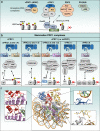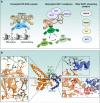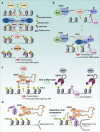Polycomb group-mediated histone H2A monoubiquitination in epigenome regulation and nuclear processes
- PMID: 33230107
- PMCID: PMC7683540
- DOI: 10.1038/s41467-020-19722-9
Polycomb group-mediated histone H2A monoubiquitination in epigenome regulation and nuclear processes
Abstract
Histone posttranslational modifications are key regulators of chromatin-associated processes including gene expression, DNA replication and DNA repair. Monoubiquitinated histone H2A, H2Aub (K118 in Drosophila or K119 in vertebrates) is catalyzed by the Polycomb group (PcG) repressive complex 1 (PRC1) and reversed by the PcG-repressive deubiquitinase (PR-DUB)/BAP1 complex. Here we critically assess the current knowledge regarding H2Aub deposition and removal, its crosstalk with PcG repressive complex 2 (PRC2)-mediated histone H3K27 methylation, and the recent attempts toward discovering its readers and solving its enigmatic functions. We also discuss mounting evidence of the involvement of H2A ubiquitination in human pathologies including cancer, while highlighting some knowledge gaps that remain to be addressed.
Conflict of interest statement
The authors declare no competing interests.
Figures







Similar articles
-
Histone H2A monoubiquitination and Polycomb repression: the missing pieces of the puzzle.Fly (Austin). 2012 Jul-Sep;6(3):162-8. doi: 10.4161/fly.20986. Epub 2012 Jul 1. Fly (Austin). 2012. PMID: 22836728
-
Polycomb-group proteins in the initiation and progression of cancer.J Genet Genomics. 2021 Jun 20;48(6):433-443. doi: 10.1016/j.jgg.2021.03.013. Epub 2021 May 1. J Genet Genomics. 2021. PMID: 34266781 Review.
-
Histone H2A deubiquitinase activity of the Polycomb repressive complex PR-DUB.Nature. 2010 May 13;465(7295):243-7. doi: 10.1038/nature08966. Epub 2010 May 2. Nature. 2010. PMID: 20436459 Free PMC article.
-
Basis of the H2AK119 specificity of the Polycomb repressive deubiquitinase.Nature. 2023 Apr;616(7955):176-182. doi: 10.1038/s41586-023-05841-y. Epub 2023 Mar 29. Nature. 2023. PMID: 36991118
-
Polycomb-dependent histone H2A ubiquitination links developmental disorders with cancer.Trends Genet. 2022 Apr;38(4):333-352. doi: 10.1016/j.tig.2021.07.011. Epub 2021 Aug 20. Trends Genet. 2022. PMID: 34426021 Review.
Cited by
-
Potential roles of UCH family deubiquitinases in tumorigenesis and chemical inhibitors developed against them.Am J Cancer Res. 2024 Jun 15;14(6):2666-2694. doi: 10.62347/OEGE2648. eCollection 2024. Am J Cancer Res. 2024. PMID: 39005671 Free PMC article. Review.
-
USP7/Maged1-mediated H2A monoubiquitination in the paraventricular thalamus: an epigenetic mechanism involved in cocaine use disorder.Nat Commun. 2023 Dec 20;14(1):8481. doi: 10.1038/s41467-023-44120-2. Nat Commun. 2023. PMID: 38123574 Free PMC article.
-
Sustained inactivation of the Polycomb PRC1 complex induces DNA repair defects and genomic instability in epigenetic tumors.Histochem Cell Biol. 2024 Jul;162(1-2):133-147. doi: 10.1007/s00418-024-02302-z. Epub 2024 Jun 18. Histochem Cell Biol. 2024. PMID: 38888809 Free PMC article.
-
Advances on Epigenetic Drugs for Pediatric Brain Tumors.Curr Neuropharmacol. 2023;21(7):1519-1535. doi: 10.2174/1570159X20666220922150456. Curr Neuropharmacol. 2023. PMID: 36154607 Free PMC article. Review.
-
Chromosome-specific maturation of the epigenome in the Drosophila male germline.Elife. 2023 Nov 30;12:RP89373. doi: 10.7554/eLife.89373. Elife. 2023. PMID: 38032818 Free PMC article.
References
Publication types
MeSH terms
Substances
LinkOut - more resources
Full Text Sources
Molecular Biology Databases
Research Materials

